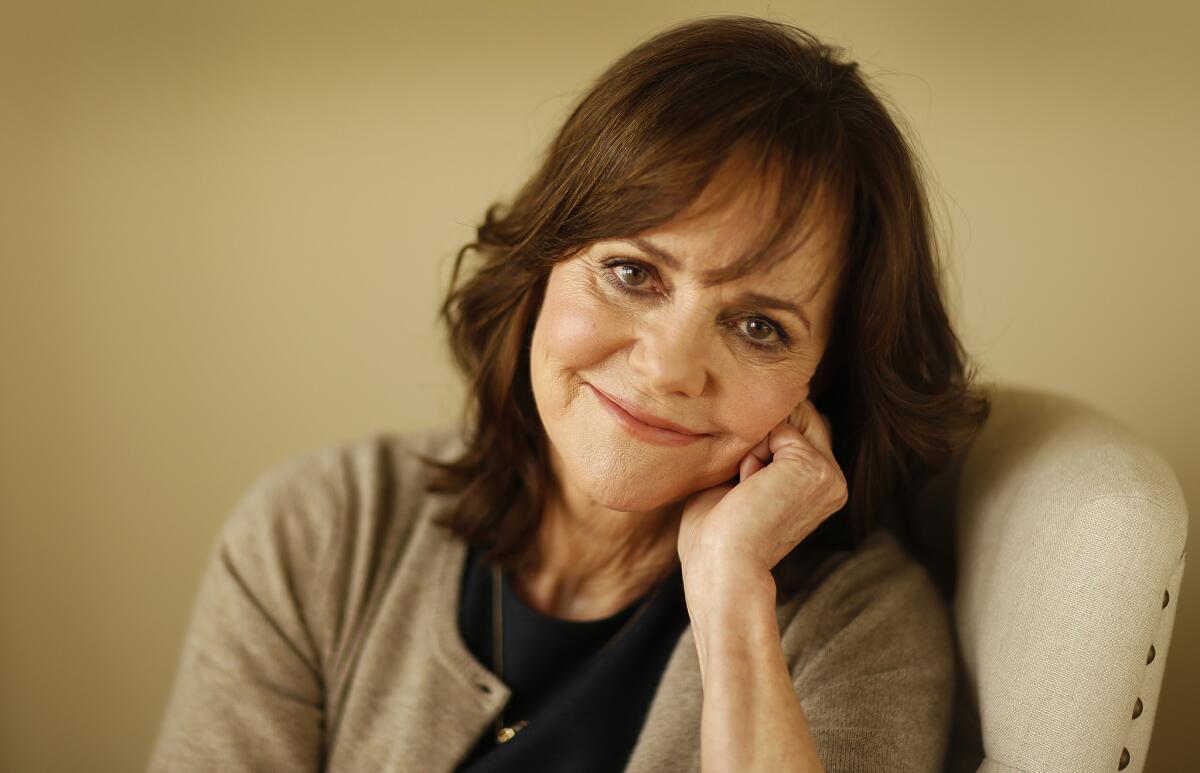Sally Field revels in playing ‘fierce, sexy, odd’ in ‘Hello, My Name Is Doris’

LOS ANGELES, CA - MARCH 02, 2016 - Two time Oscar winning actress Sally Field photographer for her new film “Hello, My Name Is Doris” on March 02, 2016. (Al Seib / Los Angeles Times)
- Share via
Sally Field believes that our age changes, but not our character.
“We are all just the same,” she said during a recent interview in Beverly Hills. “If you and I met and we were in our 20s, we could close our eyes and say, we are going to be sitting at a table 35 years from now and we will still be the same person. Your body changes.”
The petite actress, a vibrant and youthful-looking 69, lamented the “tremendous ageism” toward women in this country. “In Europe, they are so appreciated and revered. With women — especially in this industry — there is always a feeling of, ‘What have you been doing with yourself?’ I say, ‘What do you mean, what have I been doing with myself? I’m still here.’ ”
Proving her point, Field gives a lovely performance in the new indie comedy-drama “Hello, My Name Is Doris,” which opens Friday. In the film, directed and co-written by Michael Showalter (“Wet Hot American Summer”), Field plays the 60-something Doris, a true eccentric with a boring job at an online magazine populated with millennials who take her for granted.
After the death of her domineering mother, whom she long cared for in their cluttered little house on Staten Island, Doris is looking for love — in all the wrong places. She behaves like a giddy teenager when she thinks the company’s cute new young art director John (Max Greenfield) is interested in her.
Field thought of it as a coming-of-age story, just not one about youth. “We all see little pieces of ourselves in Doris,” Field believes.
The actress, who earned Oscars for her memorable turns in 1979’s “Norma Rae” and 1984’s “Places in the Heart,” was Showalter’s top choice for Doris.
“Doris is a funny, vulnerable, fierce, sexy, odd, intense character,” said Showalter. ‘I don’t think there are very many actresses besides Sally who could do justice to all of the different things that are that character. It was, like, Sally Field would be amazing, but she would never do it. To my utter delight, she responded to the part.”
“We knew this would be hard to pull off,” Field recalled of her first meeting with Showalter. “He kept saying it walks a fine line between comedy and drama. It isn’t just sort of a comedy and a drama because a lot of movies do that. It’s a Greek drama and a screwball comedy. Some of those transitions are butted right up against each other.”
Making matters more complex, Doris lives in her own world and constantly fantasizes.
“She has been cut off from the world,” Field said, “and she doesn’t really recognize that there is a world out there. She gets her clothes from thrift stores, off the streets, out of bags and kind of plays dress-up for herself. She has no connection with how she is going to be looked at.”
She also discussed Doris’ personality and hoarding issues with therapists. “The report I got back was that all of the mental disorders like OCD — they all have degrees of severity.”
Because Showalter let her “run” with Doris, Field began to imagine her unique look, including a faux bun that sits askew on the top of her head, old glasses, mismatched clothes — including a wonderful poodle skirt and saddle shoes — and a bit too much makeup.
“She lives in a time capsule in a way,” noted Field. Especially her hairdo. “I copied the hair from an old Brigitte Bardot hairdo from the early 1960s,” she said. “She has these sweeping bangs from the side. I decided the look can’t be perfect, so I cut my bangs off.”
Costume designer Rebecca Gregg went to old costume houses in Los Angeles and collected clothes for Field. “There were racks and racks of clothes,” Field recalled. “I just started trying on clothes, trying to put a look together, because in my mind, if I started to find her exterior, then I would start to find the interior.”
“She was so dedicated to the material,” said Showalter. “She was so willing to make do with the limited resources we had. Everyone worked really hard when we saw how dedicated she was.”
Field was determined to make Doris a real person, not a cartoon nor caricature. And she’s especially strong in the scenes when Doris realizes she’s suddenly free after her mother’s death.
Ultimately, it’s her young colleague John who helps bring her out of her shell.
“She talks to him like she has never done before,” said Field. “And I think John is talking to her in ways he has never done before. It is a connection of two people. No matter how old they are, that is what people want from each other.”
More to Read
Only good movies
Get the Indie Focus newsletter, Mark Olsen's weekly guide to the world of cinema.
You may occasionally receive promotional content from the Los Angeles Times.











